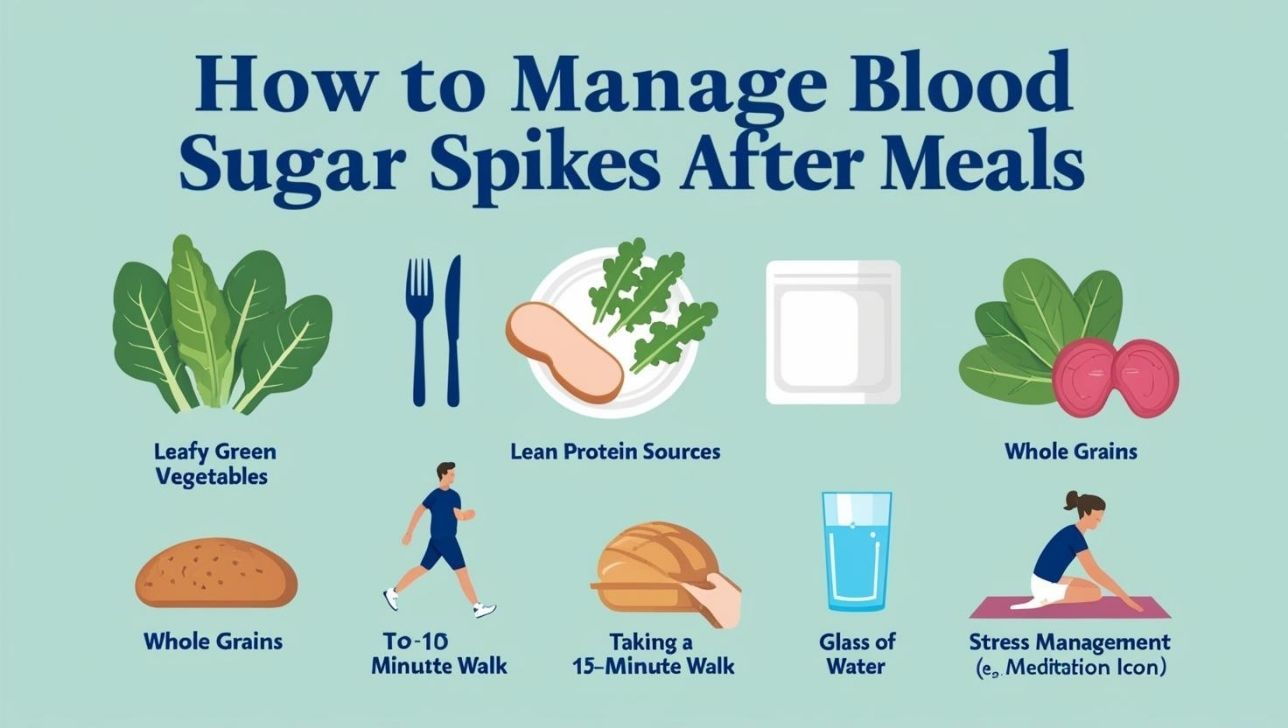Understanding Blood Sugar Spikes After Meals
When you finish a meal, your body begins processing the food you’ve consumed, which can trigger temporary increases in blood glucose levels. These natural fluctuations, known as blood sugar spikes, can impact your overall health and energy levels. Understanding how different foods influence your blood glucose can help you manage these post-meal changes effectively.
🔹 Want to Take Control of Your Blood Sugar? Read our in-depth review of Gluco6 and see how it can help you maintain stable glucose levels. Click here to read more!
Factors Contributing to Post-Meal Blood Sugar Variations
Several key elements determine how quickly and dramatically your blood sugar might rise after eating:
- Carbohydrate content of the meal
- Individual metabolic response
- Insulin sensitivity
- Physical activity level
- Overall nutritional composition of food
Certain foods cause more rapid glucose absorption, leading to more pronounced spikes. Refined carbohydrates and sugary items typically trigger faster blood sugar increases compared to complex carbohydrates and proteins.
Strategic Dietary Approaches
Implementing specific dietary strategies can help minimize dramatic blood sugar fluctuations. Prioritizing balanced meals that combine proteins, healthy fats, and complex carbohydrates creates a more stable glucose response.
Recommended Food Combinations
• Pair carbohydrates with lean proteins
• Include fiber-rich vegetables
• Choose whole grains over processed alternatives
• Incorporate healthy fats like avocado or olive oil
Practical Management Techniques
Physical movement plays a crucial role in regulating blood glucose levels. Engaging in light exercise immediately after meals can help muscles absorb glucose more efficiently, reducing potential spikes.
Consider these post-meal activity recommendations:
- Take a 10-15 minute walk
- Perform gentle stretching
- Do light household chores
- Practice standing instead of sitting after eating
Monitoring and Personal Awareness
Modern technology offers advanced tools for tracking blood sugar responses. Continuous glucose monitors provide real-time insights into how different foods impact your individual metabolism. These devices can help you understand personal glucose patterns and make informed dietary choices.
Lifestyle Modifications
Beyond immediate dietary interventions, long-term lifestyle changes significantly impact blood sugar regulation:
• Maintain consistent sleep schedules
• Manage stress through meditation or relaxation techniques
• Regular physical exercise
• Stay adequately hydrated
• Limit alcohol and processed food consumption
Nutritional Supplements and Support
Certain supplements might assist in managing blood sugar levels. Chromium, magnesium, and alpha-lipoic acid have shown potential in supporting glucose metabolism. However, always consult healthcare professionals before introducing new supplements to your routine.
Warning Signs
Persistent or extreme blood sugar fluctuations might indicate underlying health conditions. Symptoms such as frequent urination, unexplained fatigue, or extreme hunger could signal the need for professional medical evaluation.
Personalized Approach
Every individual’s metabolic response differs, making personalization key in managing blood sugar. What works effectively for one person might not yield identical results for another. Patience, consistent monitoring, and willingness to adjust strategies are essential.
Consulting registered dietitians or endocrinologists can provide tailored guidance specific to your unique physiological needs. They can help develop comprehensive strategies addressing your individual metabolic challenges and health goals.
🔹 Looking for the Best Blood Sugar Support? Discover how Gluco6 works and why so many people trust it. Read our expert review and make an informed choice today! Check it out now!
Strategic Management Techniques for Post-Meal Glucose Control
Managing blood sugar levels after meals can be challenging, but with the right strategies, you can effectively control glucose spikes and maintain better overall health. Understanding how different foods and lifestyle choices impact your blood sugar is crucial for long-term wellness.
Understanding Glucose Dynamics
When you eat, your body breaks down carbohydrates into glucose, causing blood sugar levels to rise. The speed and intensity of these spikes can vary depending on multiple factors, including the type of food consumed, portion size, and individual metabolic responses.
Balanced Meal Planning Techniques
• Prioritize low glycemic index foods
• Combine proteins with complex carbohydrates
• Include fiber-rich ingredients in every meal
• Practice portion control
Practical Intervention Strategies
Immediate post-meal actions can significantly mitigate glucose fluctuations. Physical movement is one of the most effective approaches to managing blood sugar levels. A short 10-15 minute walk after eating can help muscles absorb glucose more efficiently, reducing overall blood sugar elevation.
Nutritional Optimization Approaches
Consider incorporating foods that naturally help regulate blood sugar:
• Cinnamon
• Apple cider vinegar
• Leafy green vegetables
• Lean proteins
• Nuts and seeds
These ingredients can slow down glucose absorption and provide sustained energy without dramatic spikes.
Hydration and Glucose Management
Drinking water plays a critical role in blood sugar regulation. Proper hydration helps kidneys flush out excess glucose through urine and supports overall metabolic functions. Aim for at least 8 glasses of water daily, spreading consumption throughout the day.
Exercise Integration
Regular physical activity enhances insulin sensitivity, allowing your body to process glucose more effectively. Consistent exercise helps:
• Improve metabolic efficiency
• Reduce insulin resistance
• Stabilize blood sugar levels
• Enhance overall energy metabolism
Technology and Monitoring
Modern continuous glucose monitoring (CGM) devices provide real-time insights into how different foods impact your blood sugar. These tools can help you make informed dietary choices and understand your body’s unique metabolic responses.
Supplemental Support
Certain supplements can complement your blood sugar management strategy:
• Chromium
• Magnesium
• Alpha-lipoic acid
• Berberine
Always consult healthcare professionals before starting any supplementation regimen.
Stress Management Connection
Stress hormones like cortisol can trigger glucose release, causing unexpected spikes. Implementing stress reduction techniques such as meditation, deep breathing, and regular sleep patterns can help maintain more stable blood sugar levels.
Individual Adaptation
No single approach works identically for everyone. Personalized strategies require consistent monitoring, experimentation, and potential adjustments. Keep a detailed food and activity journal to track your body’s specific responses.
Long-Term Perspective
Sustainable blood sugar management isn’t about drastic measures but consistent, mindful choices. By integrating these strategies gradually, you can develop a comprehensive approach that supports metabolic health and prevents potential complications associated with glucose fluctuations.
Implementing these strategic techniques requires patience and commitment. Your body’s response to dietary and lifestyle modifications will evolve, so remain flexible and attentive to its signals. Regular check-ups with healthcare providers can provide additional personalized guidance in your blood sugar management journey.
🔹 Ready to Balance Your Blood Sugar Naturally? Take the next step towards better health with Gluco6. Learn more and grab your bottle today! Order now!
Conclusion
Managing blood sugar spikes after meals is a critical aspect of maintaining overall health and preventing long-term complications associated with glucose fluctuations. By implementing the strategies discussed, individuals can take proactive steps to stabilize their blood sugar levels and improve their metabolic well-being.
The key to successful blood sugar management lies in a holistic approach that combines nutrition, physical activity, and lifestyle modifications. Remember that each person’s body responds differently, so it’s essential to work closely with healthcare professionals and develop a personalized plan that suits your unique metabolic needs.
Consistent monitoring, mindful eating, and regular physical activity are your most powerful tools in controlling post-meal glucose responses. Small, strategic changes can make a significant difference in how your body processes nutrients and maintains stable blood sugar levels. Whether it’s choosing low glycemic index foods, incorporating protein and fiber, or engaging in light exercise after meals, these techniques can help minimize sudden glucose spikes.
Technology and modern health tracking can further support your efforts. Continuous glucose monitors, smart nutrition apps, and regular blood tests provide valuable insights into your body’s specific glucose patterns. By leveraging these tools and maintaining a proactive approach, you can transform blood sugar management from a challenging task to an empowering health strategy.
Ultimately, preventing blood sugar spikes is not about strict restrictions but about creating a balanced, sustainable approach to nutrition and lifestyle. With patience, knowledge, and consistent implementation of these strategies, you can achieve better metabolic health and reduce the risk of diabetes-related complications.


